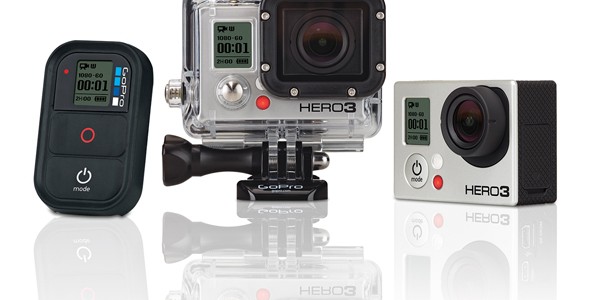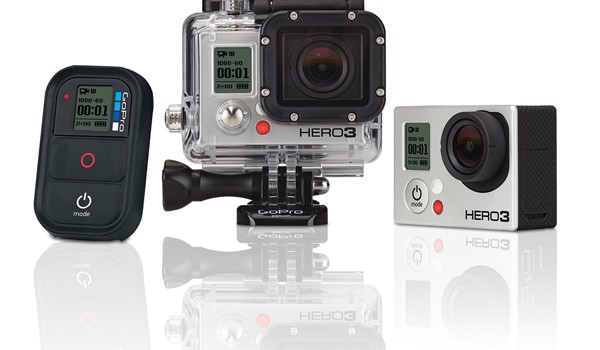

GoPro vs DSLR: Pros and Cons
Photo Taking Tips December 20, 2015 Editorial Staff 0

GoPro or DSLR? Which one to buy depends on what you want to use it for. GoPro cameras are built for live extreme-action videography. Portable, rugged, lightweight and compact, they can be mounted on bike helmets, chest harness, dog collars, surf boards, car dashboards, and just about anything. The heftier DSLR cameras on the other hand are meant for taking pictures and videos in JPEG as well as RAW file formats that are more deliberately composed. They have interchangeable lenses for different uses and have settings that can be manually adjusted for different occasions. Price-wise, buying a GoPro camera is far less expensive then a DSLR camera with a complete set of lenses and accessories. But then, there are other factors that must be considered.
GoPro
GoPro carries three fixed-lens cameras of which two are without viewfinders and one with a touchscreen viewfinder. For all three makes, there is a 2-bit LCD at the front for accessing the menu and for controlling it through the front and top shutter buttons. A GoPro camera can capture images in 5 to 12 megapixels in JPEG file format. Completely waterproof and shockproof, it can be used for filming live fast-paced action in high-definition. Mountable, even wearable, a GoPro camera can be used for taking great pictures and videos anytime and anywhere.
On the downside, with a GoPro you’re stuck with what comes already built-in with the camera – the fixed, wide-angle lens and the pre-set auto exposure. With a GoPro, the shutter speed and ISO can’t be manually controlled as you see fit for the subject or the setting of the shoot. Additionally, the GoPro can only do JPEG file formats, which allows for a more limited range of editing and finishing options than RAW files.
DSLR
A DSLR or “digital single-lens reflex” camera is a digital camera that uses a set of mirrors or a prism to direct light from the lens to the viewfinder in an almost perfect what-you-see- is-what-you-get way. With a DSLR camera, you can get faster performance and better image quality than what you’d get from even the high-end top-of-the-line point-and-shoot cameras. With it, you can also interchange lenses to suit whatever your photography needs are at the moment. Since you will be using different lenses for different shooting situations, you have to pay close attention to what will go in your initial set, in addition to the all-purpose zoom lens that’s typically bundled with the camera. However, DSLR lenses are designed to have manufacturer-specific electronic connection with the camera, meaning that, as a rule, you can only get lenses made by the same manufacturer that made your camera.
The three most common DSLR sensor sizes are ‘Full-Frame,’ ‘APS-C’ and ‘Four-Thirds.’ The smaller sensors ‘crop’ the scene and make a lens appear to have a longer focal length. The full frame, which is the largest and most expensive format, will not have such ‘crop’ factor and will produce the best results even in very low light and at higher sensitivities. The resolution of DSLR sensors is typically measured in megapixels. The larger the sensors, the higher the megapixel ratings. A larger megapixel rating however does not always mean higher quality. Most DSLR cameras come with three basic types of viewfinders: optical viewfinder (OVF), electronic viewfinder (EVF), and an LCD screen with Live View. Most modern DSLR cameras, in addition to an eye-level OVF or EVF, also have a Live View that lets you preview a scene on the camera’s LCD screen.
On the downside, aside from being relatively pricier, less compact and less handier than GoPro, DSLR cameras are not meant for really rugged live-action shooting. Fortunately, there are now some makes with built-in image stabilization (IS) systems to counteract the motion of camera shake and reduce or eliminate the resultant blurring. Some of these systems use what is called Optical IS where gyroscopes in the camera or the camera’s lens are used to detect camera shake, which then signals a response to steady the path of the image as it makes its way to the camera’s sensor. Some use digital stabilization, which attempts to make a picture clearer by simply changing the camera’s settings or by altering the image after it has been captured. Even with the built-in IS, for best results, most DSLR cameras need to be mounted on tripods for certain shoots.

No comments so far.
Be first to leave comment below.